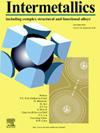合金化和时效处理对非等原子CoCrFeNi高熵合金应变硬化行为的影响
IF 4.3
2区 材料科学
Q2 CHEMISTRY, PHYSICAL
引用次数: 0
摘要
研究了AlxCo1.5CrFeNi1.5Tiy(原子比x和y之和为0.5,x = 0,0.2, 0.3, 0.5)高熵合金(HEAs)在固溶和峰时效条件下的加工硬化行为。加工硬化行为主要受时效过程中L12和B2析出相的形成以及不同Ti/Al浓度下层错(SF)形成的难易程度驱动。增加Ti浓度可降低层错能(SFE),促进层错形成,进一步增强加工硬化。B2析出相通过Orowan环诱导硬化,L12析出相通过部分位错剪切诱导硬化。在AlCoCrFeNi体系中加入Ti,导致变形机制由波浪形滑移向平面滑移转变。时效过程中形成的有序结构域有利于SF的生成,从而提高加工硬化率。此外,在含钛合金固溶条件下观察到泰勒晶格型变形亚结构,而在时效条件下则不存在,这是因为析出有利于SFs的形成,从而降低了泰勒晶格的倾向。本研究提高了对不同HEA成分加工硬化的认识,有助于结构材料合金设计的优化。本文章由计算机程序翻译,如有差异,请以英文原文为准。
Influence of alloying and aging treatment on the strain hardening behavior of non-equiatomic CoCrFeNi high entropy alloy
The objective of the study was to investigate the work hardening behavior of AlxCo1.5CrFeNi1.5Tiy (where sum of x and y is 0.5, in atomic ratio and x = 0, 0.2, 0.3, 0.5) high entropy alloys (HEAs) in solutionized and peak-aged conditions. Work hardening behaviour was mainly driven by L12 and B2 precipitate formation, during aging, and the ease of stacking fault (SF) formation with varying Ti/Al concentrations. Increasing Ti concentration was found to decrease stacking fault energy (SFE), promoting SF formation and further enhanced work hardening. B2 precipitates contributed to Orowan looping-induced hardening, while L12 precipitates induced hardening through precipitate shearing via partial dislocations. Addition of Ti into the AlCoCrFeNi system induced a transition in the deformation mechanism from wavy slip to planar slip. Ordered domains formed during aging facilitate SF generation, resulting in higher work hardening rates. In addition, Taylor lattice-type deformation substructures were observed in the solutionized condition of Ti-containing alloys and were absent in their aged counterparts because precipitation facilitates the easy formation of SFs and hence decreases the propensity of Taylor lattices. Present study enhances the understanding of work hardening in various HEA compositions, aiding in the optimization of alloy design for structural materials.
求助全文
通过发布文献求助,成功后即可免费获取论文全文。
去求助
来源期刊

Intermetallics
工程技术-材料科学:综合
CiteScore
7.80
自引率
9.10%
发文量
291
审稿时长
37 days
期刊介绍:
This journal is a platform for publishing innovative research and overviews for advancing our understanding of the structure, property, and functionality of complex metallic alloys, including intermetallics, metallic glasses, and high entropy alloys.
The journal reports the science and engineering of metallic materials in the following aspects:
Theories and experiments which address the relationship between property and structure in all length scales.
Physical modeling and numerical simulations which provide a comprehensive understanding of experimental observations.
Stimulated methodologies to characterize the structure and chemistry of materials that correlate the properties.
Technological applications resulting from the understanding of property-structure relationship in materials.
Novel and cutting-edge results warranting rapid communication.
The journal also publishes special issues on selected topics and overviews by invitation only.
 求助内容:
求助内容: 应助结果提醒方式:
应助结果提醒方式:


